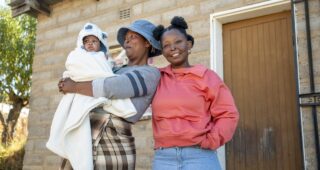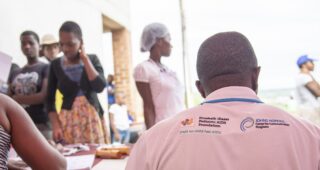EGPAF Implements a “Fisher Folk” Peer Model of Services
You are here
Hericks Omondi, 32, sits along the beaches of Lela in Homabay County in Western Kenya untangling a mess of nylon fishing nets as he waits for other fishermen to join him. The mid-day sun is looming and most of the fishermen will be coming back to the shores with their day’s catch. Hericks is a fisherman and peer educator on this beach. As a peer educator, Hericks works with outreach teams comprising clinicians, HIV Testing Services providers, and a social worker to mobilize the fisher folk for HIV testing services. He has also received training and mentorship and is able to educate his peers on various health issues. Since its Thursday, there will be a beach management unit (BMU) assembly. The BMU assembly is attended by all traders who work along the beach to discuss various matters such as security, health and sanitation, patrol, welfare, trade and education. In today’s BMU Hericks is preparing to discuss the importance of a condom.
Lela Beach has a thriving fishing industry. The burgeoning industry includes boat builders and technicians, fishing nets and gear manufacturers, boat engine mechanics, fish purchasers, sellers and processors, truck drivers who transport the fish and business men. Sex workers are also attracted to fishing beaches because of the relatively high incomes of the fishing crew.

According to the study conducted along Lake Victoria beaches by Bukusi et.,al (2014), the prevalence of HIV Infection among Fishermen was 23.3% (95% CI: 18.5 – 28.1). , . Their vulnerability stems from the amount of time spent away from home, access to cash income, poor education, the ready availability of commercial sex in fishing ports, and sub-cultures of risk-taking and hyper-masculinity, the report notes.
According to the head of the BMU of Kamolo, John Muga, fishermen vulnerability to HIV also increases due to rampant drug and alcohol abuse. “They use drugs so that they can cope with the harsh conditions in the lake, and this affects the choices they make.”
The Elizabeth Glaser Pediatric AIDS Foundation (EGPAF) in partnership with the County Government of Homabay and BMUs are implementing a model of HIV service delivery for the 42 fish landing sites (beaches) under the model termed “Fisher folk Peer Model”. As at end of December 2017, the programme had enrolled 16,241 Out of which 1,915are living with HIV.

The Fisher folk Peer Model involves offering outreach services along the beaches led by a fellow fisher folk who is trained as a peer educator. The peer educator works with outreach teams made up of clinicians, HIV testing services providers, and a social worker to offer a wide array of services. The services include HIV testing and counseling services, condom promotion and provision, psychosocial support, mitigation and management of sexual violence, alcohol and substance abuse assessment, tuberculosis screening and referral to treatment, family planning, sexual and reproductive health services, cervical cancer screening and treatment and determination of circumcision status and referral for voluntary medical male circumcision.
“These fishing communities have a documented high HIV prevalence rate as well as a very high rate of sexually transmitted infections, and there has been some research looking at factors that could be contributing to the high HIV prevalence in these populations, including the custom of jaboya, where the fishermen demand sex from the women fish traders in exchange for product,” says Lucie Adagi, a Key and Priority Populations specialist.

The fisher folk program model implemented by EGPAF has shown great success. All the 1,915 HIV positive fisher folk are currently on anti-retroviral treatment. 20 clients who have done well on treatment through good adherence to medication have graduated to receive their monthly ART refills at home and attend the hospital clinic only once in 6 months in line with Ministry of Health’s policy on Differentiated Service Delivery. 24 out of the 16,241-fisher folk (about 0.18%) have sero-converted HIV positive over the last 1 year meaning over 99.9% have remained HIV free.
Florence Dzame, Communications & Advocacy Officer, EGPAF-Kenya
Kenya
General; Strengthening Local Capacity



